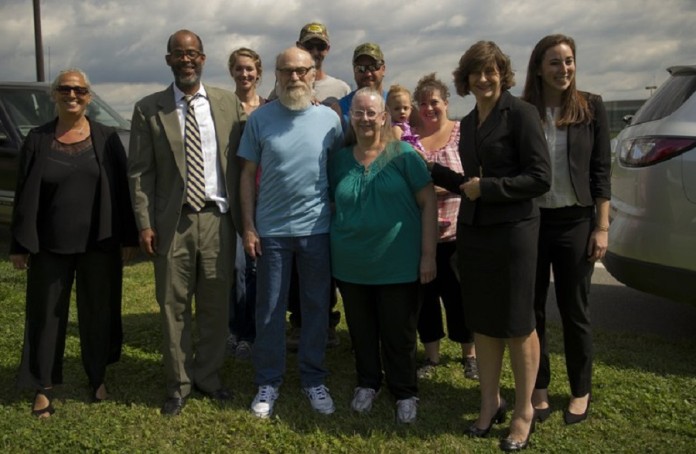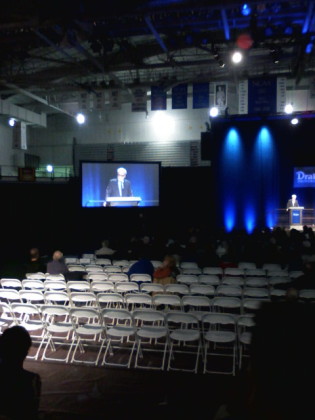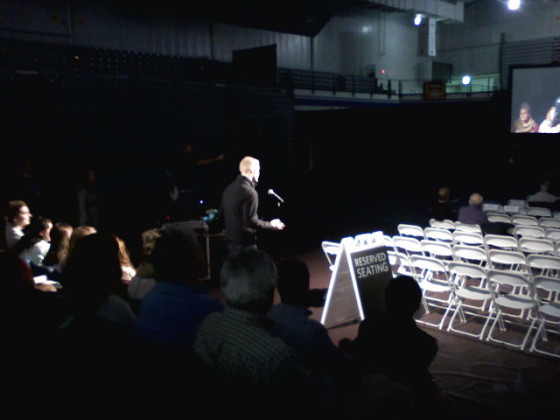
“It’s not just getting the innocent out of prison. It’s a matter of public safety,” said Peter Neufeld, co-founder and co-director of the Innocence Project. Neufeld recently spoke about the weaknesses in the U.S. criminal justice system and the horrors of wrongful imprisonment as part of the Martin Bucksbaum Distinguished Lecture Series at Drake University.
If an innocent person is behind bars, Neufeld said, then the actual perpetrator is free and most likely continuing to commit crimes against the public, crimes that could have been prevented had the right person been convicted.
Neufeld, a specialist in constitutional law and police misconduct and partner in the New York civil rights law firm of Neufeld, Scheck and Brustin, delved in his lecture into the harrowing story of Donald Gates and the 21-year-old student, Catherine Schilling, who was raped and shot repeatedly while taking a shortcut home through Rock Creek Park in Washington, D.C., on a July 1981 evening.
Neufeld described the story as a “heater” — a story the media very quickly takes up — and said senior partners at the law firm where Schilling worked were visibly and loudly demanding justice.
When a major crime happens, the police will look for other similar crimes, he said. If similar crimes are found, they then look for any suspects attached to these other crimes. Any suspect attached to a similar crime quickly becomes the suspect for the current crime under investigated.
Gates was a day laborer who sometimes stayed at a shelter and who had a record of minor encounters with law enforcement. Most recently, he had stolen someone’s briefcase, which resulted in his photo appearing in a mug shot book.
In the case of Schilling, the police did find a similar crime. A woman named Fitzsimmons had been attacked, raped and robbed less than a quarter-mile from where Schilling was raped and killed. A theory was developed: Schilling was a rape and robbery gone wrong committed by the same person who attacked Fitzsimmons.
Fitzsimmons was brought in to view some photos and when Gates’ photo was shown to her, she identified him as the rapist. About the same time, a jailhouse informant came forward, stating Gates had bragged to him about wanting only to steal Schilling’s bag but then turned it into a rape and finally shot and killed her.
Neufeld noted this informant wanted money for providing this information to the police and expected to have his own outstanding criminal cases taken care of.
Gates was apprehended and charged with the Fitzsimmons rape and the Schilling murder. Upon further investigation, it was found that at the time of the Fitzsimmons attack, Gates had been serving 30 days in jail for the briefcase theft. While cleared of the Fitzsimmons charges, Gates remained charged for the Schilling murder.
Keep in mind, Neufeld said, one of the key reasons Gates was connected to the Schilling case was due to his presumed link to the Fitzsimmons case, and this Fitzsimmons link had now disappeared.
The police, of course, also pursued physical evidence. An examination of the physical evidence, the rape kit, was inconclusive. Two hairs were sent to the FBI crime lab, where it was concluded that the hairs matched. Hair, unlike DNA, is not unique, Neufeld noted.
Upon examination of the FBI agent hair analyst’s report, it was stated that the hair was “similar” to Gates’ hair sample, but as part of his testimony at trial, the FBI agent stated the hairs were “microscopically indistinguishable.”
Donald Gates was convicted and sentenced to life in prison.
Neufeld said hair analysis in the 1980s (and even today) was not the absolute science viewers of TV’s CSI (largely fiction) may believe. In 1988, DNA had become a crime-solving tool, and Gates requested and was granted a DNA test on the hairs.
Unfortunately, the science was still new, and the results were inconclusive, so Gates’ life sentence stood. In 2007 Gates again requested DNA analysis. The request was granted two years later. By this time, the science had advanced and enabled specific results.
Twenty-seven years after Schilling’s murder, Gates was “excluded as the source of the semen.”
When the DNA results were entered into the database, there was a “cold hit” back to a temporary janitor who worked at the law firm where Schilling was working.
The Innocence Project has achieved 333 exonerations, including 19 from death row. One prisoner was only five days from execution and another nine. Neufeld believes these cases are just the tip of the iceberg, especially considering that 90 percent to 95 percent of case have no biological evidence to re-examine.
On average, the innocent serve 14 years before being exonerated. One-hundred forty of the actual perpetrators have been found. As stated in the lecture series’ flyer, “The Project currently represents hundreds of inmates seeking post-conviction release through DNA testing and pursues institutional reform to identify and address the systemic causes of wrongful convictions.”
The major causes are listed on the Innocence Project website in categories, such as eyewitness misidentification, unvalidated or improper forensic science, false confessions or admissions, government misconduct, informants and inadequate defense.
The Innocence Project works to research and examine the causes of wrongful conviction, looking to identify techniques and processes to decrease and avoid such convictions.
Neufeld repeatedly stated it is a matter of public safety that the janitor who raped and murdered Schilling went on to commit other crimes, including the vicious stabbing of a woman. Had the right man originally been tried and convicted, public safety would have been enhanced.
The Innocence Project has analyzed the wrongful convictions of the 333 exonerated to see what patterns emerge. Neufeld stated that 75 percent of the wrongful convictions are due to misidentifications. Oftentimes, the police believe they know who did it and inadvertently, or advertently, make suggestive remarks to witnesses.
A statement as simple as, “What about number three (insert witness’s name)?” may sway a witness to the suspect favored by the police. A simple solution to this problem would be to have different police officers run the witness identification process from the police officers who are running the investigation.
It is hard to influence a witness toward the favored suspect if you are not part of the investigation and are unaware of the favored suspect.
Another major cause of wrongful convictions may seem very counter-intuitive, but it is false confessions. Juveniles, people with mental disabilities or mental illnesses or simply people who are more compliant and want to please the interviewer are more likely to falsely confess.
Oftentimes, the person just wants the interrogation to end, and they believe that the evidence will set them free. Neufeld found that 25 percent of the wrongfully convicted were “stone-cold innocent and confessed.” His simple solution here is to videotape all of the interviews.
Neufeld next went on to highlight the 50 percent of wrongful convictions due to the misapplication of forensic science.
“Lawyers are scientifically illiterate,” he said. “Judges are scientifically illiterate,” and we need to “get it right before it goes to a courtroom.”
Neufeld compared the criminal justice process to what agencies such as the FDA go through in order to make sure that a drug is ready for the consumer before it goes to market. In brief, scientists decide. He lamented there is no similar regulatory body for forensic science and repeated that the courtroom is ill-suited to decide these scientific issues.
The FBI is currently reanalyzing 2,500 old cases. In May 2015, the Innocence Project reported that after reviewing 300 trial transcripts, it was found FBI agents either provided scientifically invalid testimony or misled the jury in 96 percent of the cases. In a review of 28 hair analyses, 26 included “gross exaggerations” or scientific errors.
Neufeld said the FBI has acknowledged its duty to correct this practice that went on for over two decades, and he lauded U.S. Senator Charles Grassley for holding the FBI’s feet to the fire.
Neufeld explained that DNA has a medical application, and therefore the process of DNA analysis has been through the gauntlet of basic scientific research and thousands of peer-reviewed articles. This is not the case for areas of forensic science for which there is no medical application, such as bullet comparisons or bite mark analyses.
Therefore, when bullet, bite mark or other non-DNA evidence is introduced as evidence in a trial, it is not done by people who are “steeped in applied research and peer-reviewed articles.” If a judge accepts the evidence, then it is valid, Neufeld said.
Neufeld proposes making forensic science much more rigorous, of “using evidence that is empirically based.” If we use the “most robust scientific evidence,” he said, then ultimately we will have a system that we are “proud to call a justice system.”
Legislation is needed requiring only validated techniques be used in criminal cases, he said.
“The issue should not have to be duked out in a courtroom between labs,” said Neufeld. He compared the situation to a child with strep throat, where there is no concern that different labs will give different results because there are universal standards in place.
Neufeld also touched on the “miserable defense lawyers” the accused often are provided, overworked, underpaid lawyers who have no resources to investigate effectively or research their cases. Not only are defense lawyers miserable but prosecutorial misconduct also increases the likelihood of wrongful convictions, he said.
Neufeld talked about important exculpatory evidence that is buried by prosecuting lawyers when it is their legal duty to turn it over to the defense. The audience audibly expressed their shock when he explained it is not only difficult to sanction police officers who bury evidence but the system grants absolute immunity to prosecutors who may “willfully, maliciously and deliberately” bury evidence. They cannot be sued.
Neufeld said the solution is to get rid of the immunity that prosecutors enjoy, change the culture of police departments and prosecutors’ offices and move from the mentality that “it takes skill to convict the innocent” to one of “considering discordant data.”
Neufeld ended with a topic for which he admits he has no recommended fix: race and racism. The numbers starkly show it is a factor in wrongful convictions. For example, blacks who are ultimately exonerated are in prison two to three years longer on average before exoneration than whites.
When individuals are exonerated, most receive no compensation. Gates was given $75 and a bus ticket to Ohio. Neufeld believes it is our moral obligation to provide medical assistance, financial assistance, therapy and vocational skills to victims of wrongful conviction.
He said in his experience the exonerated are almost all at peace, very spiritual and have forgiven the prosecutors and the police, but they expect to get help and they do not get it. They are not hired. Apartments are not rented to them. They are denied loans. The injustice continues.
The U.S. Constitution entitles everyone to a fair trial. Clearly, Neufeld said, more must be done to ensure wrongful convictions are minimized and eliminated and that justice prevails, both for the innocent and for the safety of all.
For more information about the Innocence Project, visit the organization’s nationwide website and its Iowa chapter’s website.
When not acting as primary counsel, Mr. Neufeld has provided pro bono services to dozens of lawyers representing the accused in death penalty cases. He has lectured and taught students, lawyers, judges, legislators and scientists on subjects at the intersection of science and criminal justice. Before co-founding the Innocence Project, Mr. Neufeld taught trial advocacy at Fordham University Law School.





















